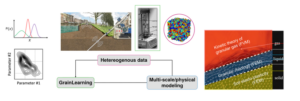Hongyang Cheng
University of Twente, The Netherlands
Granular materials exist in various sizes and shapes and are often subject to complex motions, ranging from quasi-static to free-flowing. Predicting the bulk behavior of granular materials is difficult because of the randomness in their microstructure and particle-scale properties. Although advanced laboratory testing is making observations of particles more accessible, the data typically characterize physical processes at a given length scale (e.g., particle or continuum).
Starting from the particle-scale modeling of granular materials using the discrete element method (DEM), the particle-scale uncertainty can be quantified using Bayesian inference. In an effort of minimizing the variance, uncertainty quantification reduces to calibration. Moving to the macroscopic, continuum level, there exist phenomenological constitutive models, well-established for granular materials in solid-like or fluid-like regimes. The emerging methodological challenges are to couple these “best available models” in complex situations where a transition (e.g., from continuum to discrete) occurs and to propagate particle-scale uncertainty to the continuum level and vice versa; both are essential to developing a predictive digital twin.
This presentation aims to introduce probabilistic and data-driven techniques that allow efficient integration of data, at both particle and continuum scales and it is split into three parts: (1) the hierarchical Bayesian approach (2) a combination of data-driven and physics-based modeling for uncertainty quantification, and (3) the coupling of best available models (discrete and continuum) as the most accurate and efficient digital representation of granular materials.
